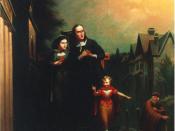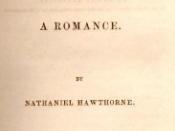Ambiguity, which is doubleness or inconclusiveness of meaning, is an important characteristic of Hawthorne's style in The Scarlet Letter. Constantly used throughout the story, ambiguity continually keeps the readers attention. Examples of ambiguity are clearly seen throughout the book.
When Hester Prynne is leaving the prison, Hawthorn briefly describes a rosebush In front of the prison. Hawthorne says, "â¦or whether, as there is fair authority for believing it had sprung up under the footsteps of the sainted Ann Hutchinson"(34). This statement is mixed with ambiguity and the mockery of the Puritans. Hawthorne is mocking the fact that the Puritans add a supernatural essence to every day occurrences. Still, one must decide if Ann Hutchinson had any thing to do with the planting of the rose bush.
Another scene of ambiguity is seen when Dimmesdale questions Chillingsworth about the herbs he has collected. The response Dimmesdale receives startles him. Chillingsworth answers Dimmesdale's question by telling him he collected the herbs from the graveyard.
Specifically, Chillingsworth tells Dimmesdale the herbs come from the heart of a man who died with an unconfessed sin in his heart. In this scene, Chillingsworth is pulling for a confession from Dimmesdale. Dimmesdale is in an extreme frail state of mind because with a sin lying heavily on his heart. He is confused and desperately looking for a way to confess his sin. It is possible that Dimmesdale creates this whole conversation as a way to relieve himself from some of the guilt that he feels for the sin he committed. Dimmesdale's mind is clouded and he is frantically looking for a way out. He needs relief from his guilt and he is willing to do anything that will ease him of guilt as long as he does not have to suffer any consequences for his sin.
Finally, the last example of ambiguity seen in The Scarlet Letter takes place on the scaffold. Dimmesdale's bare chest is seen, and the accounts given by the townspeople differ.
"Most of the spectators testified to having seen, on the breast of the unhappy minister, a SCARLET LETTER-the very semblance of that worn by Hester Prynne-imprinted in the fleshâ¦certain persons, who were spectators of the whole scene, and professed never once to have removed their eyes from the Reverend Mr. Dimmesdale, denied that there was any mark whatever on his breast"(176,177).
Due to the use of ambiguity, one does not know whether or not to believe that there is truly a mark on Dimmesdale's chest. The reader experiences mixed emotions as one tries to decide what is truth. Constant confusion is placed into the readers mind to keep the novel interesting.
Hawthorne's use of ambiguity in the story keeps the reader alert. He mixes this technique along with irony and symbolism to captivate and hold the readers attention. His techniques dictate a well-thought and planned story line. Ambiguity in Hawthorne's novel is one way he adds a certain level of conciseness that every romantic story requires.





